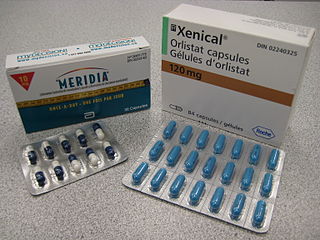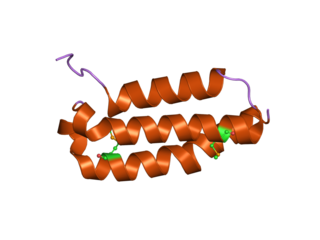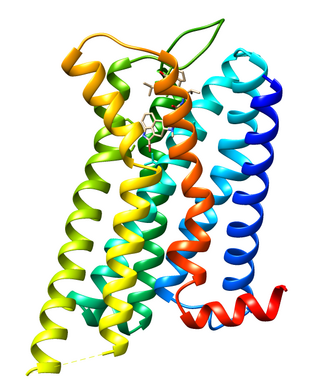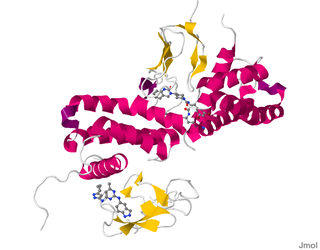Related Research Articles

Histamine is an organic nitrogenous compound involved in local immune responses communication, as well as regulating physiological functions in the gut and acting as a neurotransmitter for the brain, spinal cord, and uterus. Since histamine was discovered in 1910, it has been considered a local hormone (autocoid) because it lacks the classic endocrine glands to secrete it; however, in recent years, histamine has been recognized as a central neurotransmitter. Histamine is involved in the inflammatory response and has a central role as a mediator of itching. As part of an immune response to foreign pathogens, histamine is produced by basophils and by mast cells found in nearby connective tissues. Histamine increases the permeability of the capillaries to white blood cells and some proteins, to allow them to engage pathogens in the infected tissues. It consists of an imidazole ring attached to an ethylamine chain; under physiological conditions, the amino group of the side-chain is protonated.

Sumatriptan, sold under the brand name Imitrex among others, is a medication used to treat migraine headaches and cluster headaches. It is taken orally, intranasally, or by subcutaneous injection. Therapeutic effects generally occur within three hours.

A receptor antagonist is a type of receptor ligand or drug that blocks or dampens a biological response by binding to and blocking a receptor rather than activating it like an agonist. Antagonist drugs interfere in the natural operation of receptor proteins. They are sometimes called blockers; examples include alpha blockers, beta blockers, and calcium channel blockers. In pharmacology, antagonists have affinity but no efficacy for their cognate receptors, and binding will disrupt the interaction and inhibit the function of an agonist or inverse agonist at receptors. Antagonists mediate their effects by binding to the active site or to the allosteric site on a receptor, or they may interact at unique binding sites not normally involved in the biological regulation of the receptor's activity. Antagonist activity may be reversible or irreversible depending on the longevity of the antagonist–receptor complex, which, in turn, depends on the nature of antagonist–receptor binding. The majority of drug antagonists achieve their potency by competing with endogenous ligands or substrates at structurally defined binding sites on receptors.

Anti-obesity medication or weight loss medications are pharmacological agents that reduce or control excess body fat. These medications alter one of the fundamental processes of the human body, weight regulation, by: reducing appetite and consequently energy intake, increasing energy expenditure, redirecting nutrients from adipose to lean tissue, or interfering with the absorption of calories.

Amylin, or islet amyloid polypeptide (IAPP), is a 37-residue peptide hormone. It is co-secreted with insulin from the pancreatic β-cells in the ratio of approximately 100:1 (insulin:amylin). Amylin plays a role in glycemic regulation by slowing gastric emptying and promoting satiety, thereby preventing post-prandial spikes in blood glucose levels.
Neurogenic inflammation is inflammation arising from the local release by afferent neurons of inflammatory mediators such as Substance P, Calcitonin Gene-Related Peptide (CGRP), neurokinin A (NKA), and endothelin-3 (ET-3). In such neurons, release of these pro-inflammatory mediators is thought to be triggered by the activation of ion channels that are the principal detectors of noxious environmental stimuli. In particular, the heat/capsaicin receptor TRPV1 and the irritant/wasabi receptor TRPA1. TRPA1 channels stimulated by lipopolysaccharide (LPS) may also cause acute neurogenic inflammation. Once released, these neuropeptides induce the release of histamine from adjacent mast cells. In turn, histamine evokes the release of substance P and calcitonin gene-related peptide; thus, a bidirectional link between histamine and neuropeptides in neurogenic inflammation is established.

A muscarinic agonist is an agent that activates the activity of the muscarinic acetylcholine receptor. The muscarinic receptor has different subtypes, labelled M1-M5, allowing for further differentiation.

Calcitonin gene-related peptide (CGRP) is a member of the calcitonin family of peptides consisting of calcitonin, amylin, adrenomedullin, adrenomedullin 2 (intermedin) and calcitonin‑receptor‑stimulating peptide. Calcitonin is mainly produced by thyroid C cells whilst CGRP is secreted and stored in the nervous system. This peptide, in humans, exists in two forms: CGRP alpha, and CGRP beta. α-CGRP is a 37-amino acid neuropeptide and is formed by alternative splicing of the calcitonin/CGRP gene located on chromosome 11. β-CGRP is less studied. In humans, β-CGRP differs from α-CGRP by three amino acids and is encoded in a separate, nearby gene. The CGRP family includes calcitonin (CT), adrenomedullin (AM), and amylin (AMY).

The calcitonin receptor (CT) is a G protein-coupled receptor that binds the peptide hormone calcitonin and is involved in maintenance of calcium homeostasis, particularly with respect to bone formation and metabolism.

Adrenomedullin is a vasodilator peptide hormone of uncertain significance in human health and disease. It was initially isolated in 1993 from a pheochromocytoma, a tumor of the adrenal medulla: hence the name.

Receptor activity modifying protein 1 is a protein that in humans is encoded by the RAMP1 gene.

Receptor activity modifying protein 2, also known as RAMP2, is a protein which in humans is encoded by the RAMP2 gene.

Antimigraine drugs are medications intended to reduce the effects or intensity of migraine headache. They include drugs for the treatment of acute migraine symptoms as well as drugs for the prevention of migraine attacks.

Dopamine receptor D2, also known as D2R, is a protein that, in humans, is encoded by the DRD2 gene. After work from Paul Greengard's lab had suggested that dopamine receptors were the site of action of antipsychotic drugs, several groups, including those of Solomon Snyder and Philip Seeman used a radiolabeled antipsychotic drug to identify what is now known as the dopamine D2 receptor. The dopamine D2 receptor is the main receptor for most antipsychotic drugs. The structure of DRD2 in complex with the atypical antipsychotic risperidone has been determined.

Calcitonin receptor-like (CALCRL), also known as the calcitonin receptor-like receptor (CRLR), is a human protein; it is a receptor for calcitonin gene-related peptide.
Glucagon-like peptide-1 (GLP-1) receptor agonists, also known as GLP-1 analogs, GLP-1DAs or incretin mimetics, are a class of drugs that reduce blood sugar and energy intake by activating the GLP-1 receptor. They mimic the actions of the endogenous incretin hormone GLP-1 that is released by the gut after eating.
Zucapsaicin (Civanex) is a medication used to treat osteoarthritis of the knee and other neuropathic pain. Zucapsaicin is a member of phenols and a member of methoxybenzenes. It is a modulator of transient receptor potential cation channel subfamily V member 1 (TRPV-1), also known as the vanilloid or capsaicin receptor 1 that reduces pain, and improves articular functions. It is the cis-isomer of capsaicin. Civamide, manufactured by Winston Pharmaceuticals, is produced in formulations for oral, nasal, and topical use.
Calcitonin gene-related peptide (CGRP) receptor antagonists are a class of drugs that act as antagonists of the calcitonin gene-related peptide receptor (CGRPR).
Deborah Lucy Hay is a New Zealand academic. In 2022, she was elected a Fellow of the Royal Society Te Apārangi.
Dual amylin and calcitonin receptor agonists (DACRAs) are a class of drugs that act as agonists at the amylin receptor and calcitonin receptor that are under development as therapies for obesity and type 2 diabetes. Examples are cagrilintide and the KBP family derived from salmon calcitonin, including KBP‐042, KBP-066A, KBP-089, and KBP-336.
References
- ↑ Hay, D.L.; Christopoulos, G.; Christopoulos, A.; Sexton, P.M. (2004). "Amylin receptors: molecular composition and pharmacology". Biochemical Society Transactions. 32 (5): 865–867. doi:10.1042/BST0320865. PMID 15494035.
- ↑ Cao, Jianjun; Belousoff, Matthew J.; Liang, Yi-Lynn; Johnson, Rachel M.; Josephs, Tracy M.; Fletcher, Madeleine M.; Christopoulos, Arthur; Hay, Debbie L.; Danev, Radostin; Wootten, Denise; Sexton, Patrick M. (25 March 2022). "A structural basis for amylin receptor phenotype". Science. 375 (6587): eabm9609. doi:10.1126/science.abm9609. ISSN 0036-8075. PMID 35324283. S2CID 247677182.
- ↑ Dehestani, Babak; Stratford, Nicholas RS; le Roux, Carel W (30 December 2021). "Amylin as a Future Obesity Treatment". Journal of Obesity & Metabolic Syndrome. 30 (4): 320–325. doi:10.7570/jomes21071. ISSN 2508-6235. PMC 8735818 . PMID 34929674.
- ↑ Bower, Rebekah L; Hay, Debbie L (June 2016). "Amylin structure–function relationships and receptor pharmacology: implications for amylin mimetic drug development". British Journal of Pharmacology. 173 (12): 1883–1898. doi:10.1111/bph.13496. ISSN 0007-1188. PMC 4882495 . PMID 27061187.
- ↑ Garelja, Michael L.; Walker, Christopher S.; Hay, Debbie L. (February 2022). "CGRP receptor antagonists for migraine. Are they also AMY 1 receptor antagonists?". British Journal of Pharmacology. 179 (3): 454–459. doi: 10.1111/bph.15585 . ISSN 0007-1188. PMID 34076887. S2CID 235296644.
- ↑ Hay, Debbie L. (May 2017). "Amylin". Headache: The Journal of Head and Face Pain. 57 (S2): 89–96. doi:10.1111/head.13077. PMID 28485843. S2CID 221752755.
- ↑ Sonne, Nina; Karsdal, Morten A.; Henriksen, Kim (1 April 2021). "Mono and dual agonists of the amylin, calcitonin, and CGRP receptors and their potential in metabolic diseases". Molecular Metabolism. 46: 101109. doi:10.1016/j.molmet.2020.101109. ISSN 2212-8778. PMC 8085567 . PMID 33166741.
- ↑ Fu, Wen; Patel, Aarti; Kimura, Ryoichi; Soudy, Rania; Jhamandas, Jack H. (August 2017). "Amylin Receptor: A Potential Therapeutic Target for Alzheimer's Disease". Trends in Molecular Medicine. 23 (8): 709–720. doi:10.1016/j.molmed.2017.06.003. PMID 28694141.
- ↑ Mietlicki-Baase, Elizabeth G. (1 July 2018). "Amylin in Alzheimer's disease: Pathological peptide or potential treatment?". Neuropharmacology. 136 (Pt B): 287–297. doi:10.1016/j.neuropharm.2017.12.016. ISSN 0028-3908. PMC 5994175 . PMID 29233636.